Page 2489 of 4264
ENGINE MECHANICAL (C24SE) 6A-69
FUEL INJECTION SYSTEM
MAP SENSOR
Removal
1. Disconnect the battery cable.
2. Disconnect the electrical connector from the sensor.
3. Remove the mounting bolts securing the sensor to the manifold.
4. Remove the sensor from the intake manifold.
Installation
1. Push MAP sensor into the manifold.
2. Install the mounting bolts and tighten them.
3. Connect electrical connector.
4. Connect the battery cable.
Pressure Regulator
Removal
1. Remove vacuum hose.
2. Remove fuel hoses.
3. Remove pressure regulator.
Installation
1. Install pressure regulator.
2. Install fuel hoses.
3. Install vacuum hoses.
ECM (Engine Control Module)
Removal
(2.4L)
1. Disconnect the ECM connector.
2. Remove the four hex bolts and nuts.
3. Remove the ECM from the ECM bracket on engine.
Page 2492 of 4264
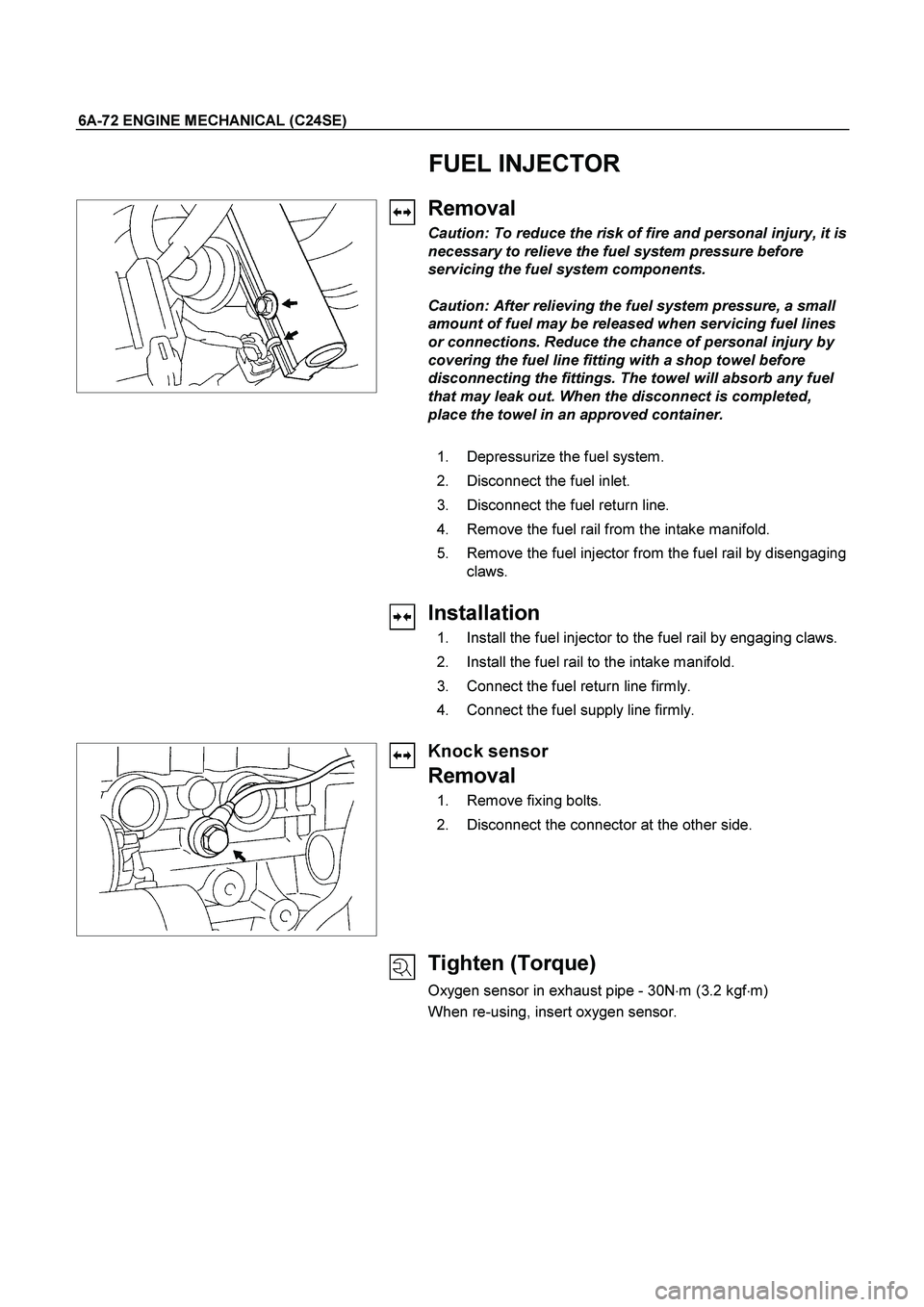
6A-72 ENGINE MECHANICAL (C24SE)
FUEL INJECTOR
Removal
Caution: To reduce the risk of fire and personal injury, it is
necessary to relieve the fuel system pressure before
servicing the fuel system components.
Caution: After relieving the fuel system pressure, a small
amount of fuel may be released when servicing fuel lines
or connections. Reduce the chance of personal injury by
covering the fuel line fitting with a shop towel before
disconnecting the fittings. The towel will absorb any fuel
that may leak out. When the disconnect is completed,
place the towel in an approved container.
1. Depressurize the fuel system.
2. Disconnect the fuel inlet.
3. Disconnect the fuel return line.
4. Remove the fuel rail from the intake manifold.
5. Remove the fuel injector from the fuel rail by disengaging
claws.
Installation
1. Install the fuel injector to the fuel rail by engaging claws.
2. Install the fuel rail to the intake manifold.
3. Connect the fuel return line firmly.
4. Connect the fuel supply line firmly.
Knock sensor
Removal
1. Remove fixing bolts.
2. Disconnect the connector at the other side.
Tighten (Torque)
Oxygen sensor in exhaust pipe - 30N�
m (3.2 kgf�
m)
When re-using, insert oxygen sensor.
Page 2525 of 4264
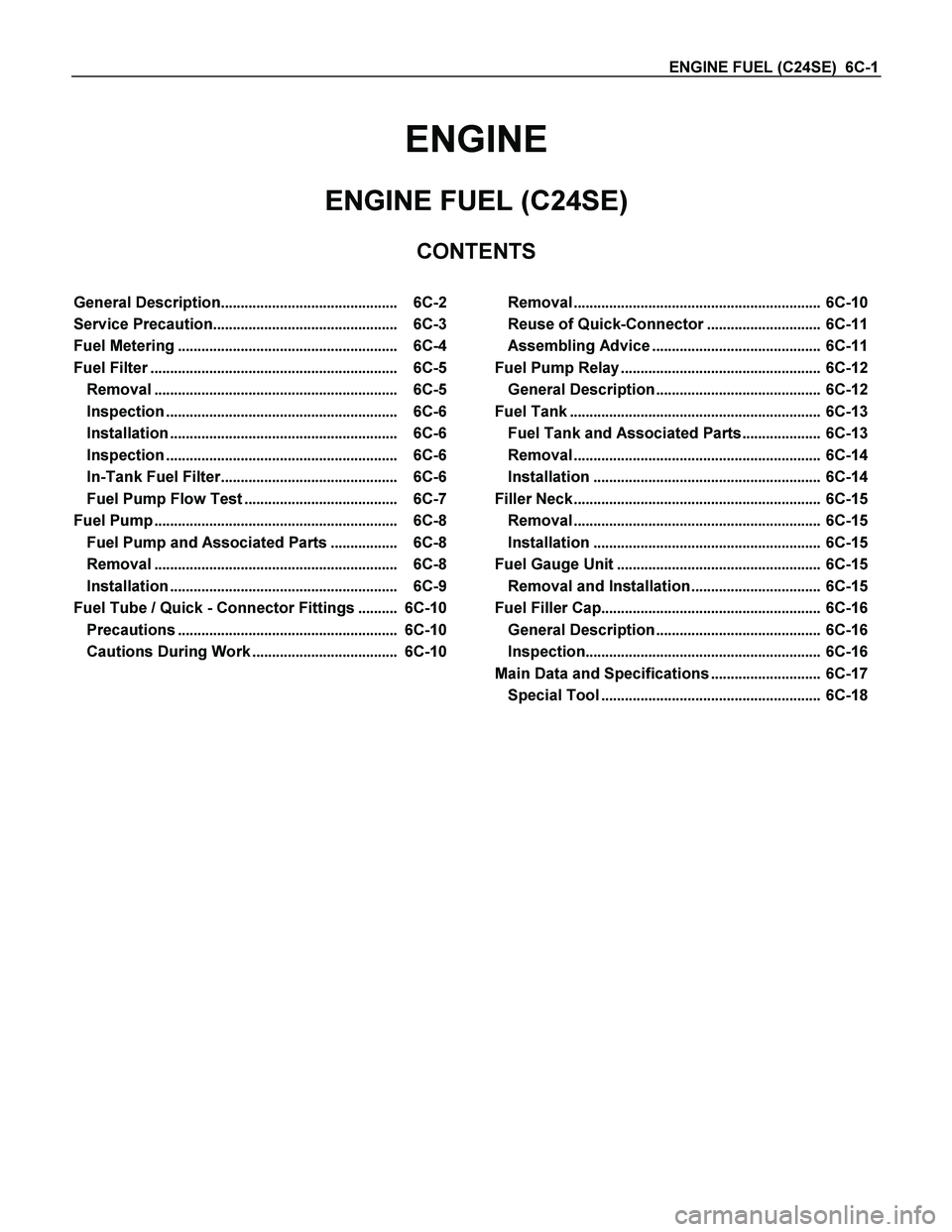
ENGINE FUEL (C24SE) 6C-1
ENGINE
ENGINE FUEL (C24SE)
CONTENTS
General Description............................................. 6C-2
Service Precaution............................................... 6C-3
Fuel Metering........................................................ 6C-4
Fuel Filter............................................................... 6C-5
Removal.............................................................. 6C-5
Inspection........................................................... 6C-6
Installation.......................................................... 6C-6
Inspection........................................................... 6C-6
In-Tank Fuel Filter............................................. 6C-6
Fuel Pump Flow Test....................................... 6C-7
Fuel Pump.............................................................. 6C-8
Fuel Pump and Associated Parts................. 6C-8
Removal.............................................................. 6C-8
Installation.......................................................... 6C-9
Fuel Tube / Quick - Connector Fittings.......... 6C-10
Precautions........................................................ 6C-10
Cautions During Work..................................... 6C-10
Removal............................................................... 6C-10
Reuse of Quick-Connector............................. 6C-11
Assembling Advice........................................... 6C-11
Fuel Pump Relay................................................... 6C-12
General Description.......................................... 6C-12
Fuel Tank................................................................ 6C-13
Fuel Tank and Associated Parts.................... 6C-13
Removal............................................................... 6C-14
Installation.......................................................... 6C-14
Filler Neck............................................................... 6C-15
Removal............................................................... 6C-15
Installation.......................................................... 6C-15
Fuel Gauge Unit.................................................... 6C-15
Removal and Installation................................. 6C-15
Fuel Filler Cap........................................................ 6C-16
General Description.......................................... 6C-16
Inspection............................................................ 6C-16
Main Data and Specifications............................ 6C-17
Special Tool........................................................ 6C-18
Page 2526 of 4264
6C-2 ENGINE FUEL (C24SE)
General Description
*
*
*
* Applicable to EVAP Emission Control System
** Not applicable to EVAP Emission Control System
Page 2527 of 4264
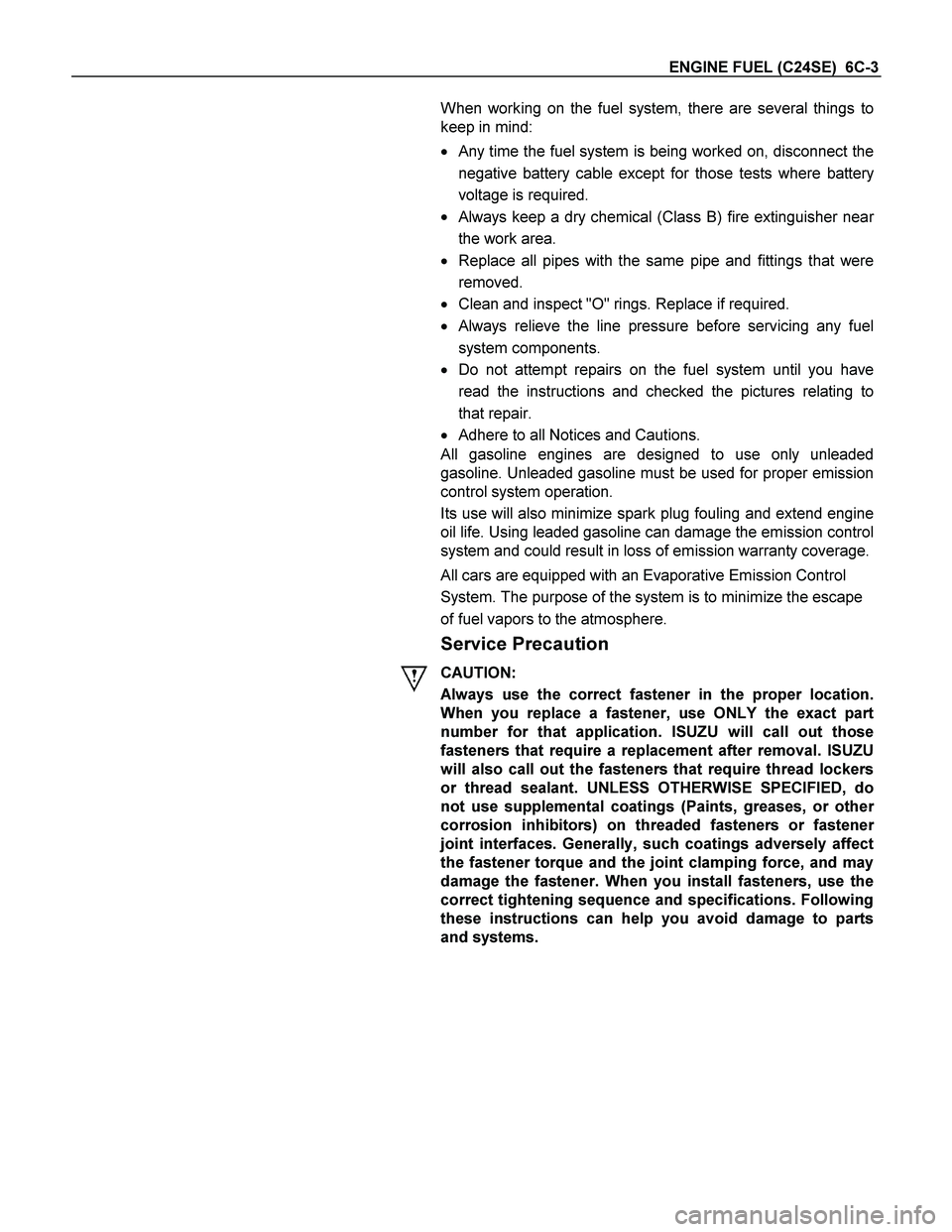
ENGINE FUEL (C24SE) 6C-3
When working on the fuel system, there are several things to
keep in mind:
�
Any time the fuel system is being worked on, disconnect the
negative battery cable except for those tests where battery
voltage is required.
�
Always keep a dry chemical (Class B) fire extinguisher near
the work area.
� Replace all pipes with the same pipe and fittings that were
removed.
� Clean and inspect "O" rings. Replace if required.
�
Always relieve the line pressure before servicing any fuel
system components.
� Do not attempt repairs on the fuel system until you have
read the instructions and checked the pictures relating to
that repair.
� Adhere to all Notices and Cautions.
All gasoline engines are designed to use only unleaded
gasoline. Unleaded gasoline must be used for proper emission
control system operation.
Its use will also minimize spark plug fouling and extend engine
oil life. Using leaded gasoline can damage the emission control
system and could result in loss of emission warranty coverage.
All cars are equipped with an Evaporative Emission Control
System. The purpose of the system is to minimize the escape
of fuel vapors to the atmosphere.
Service Precaution
CAUTION:
Always use the correct fastener in the proper location.
When you replace a fastener, use ONLY the exact part
number for that application. ISUZU will call out those
fasteners that require a replacement after removal. ISUZU
will also call out the fasteners that require thread lockers
or thread sealant. UNLESS OTHERWISE SPECIFIED, do
not use supplemental coatings (Paints, greases, or othe
r
corrosion inhibitors) on threaded fasteners or fastene
r
joint interfaces. Generally, such coatings adversely affect
the fastener torque and the joint clamping force, and may
damage the fastener. When you install fasteners, use the
correct tightening sequence and specifications. Following
these instructions can help you avoid damage to parts
and systems.
Page 2528 of 4264
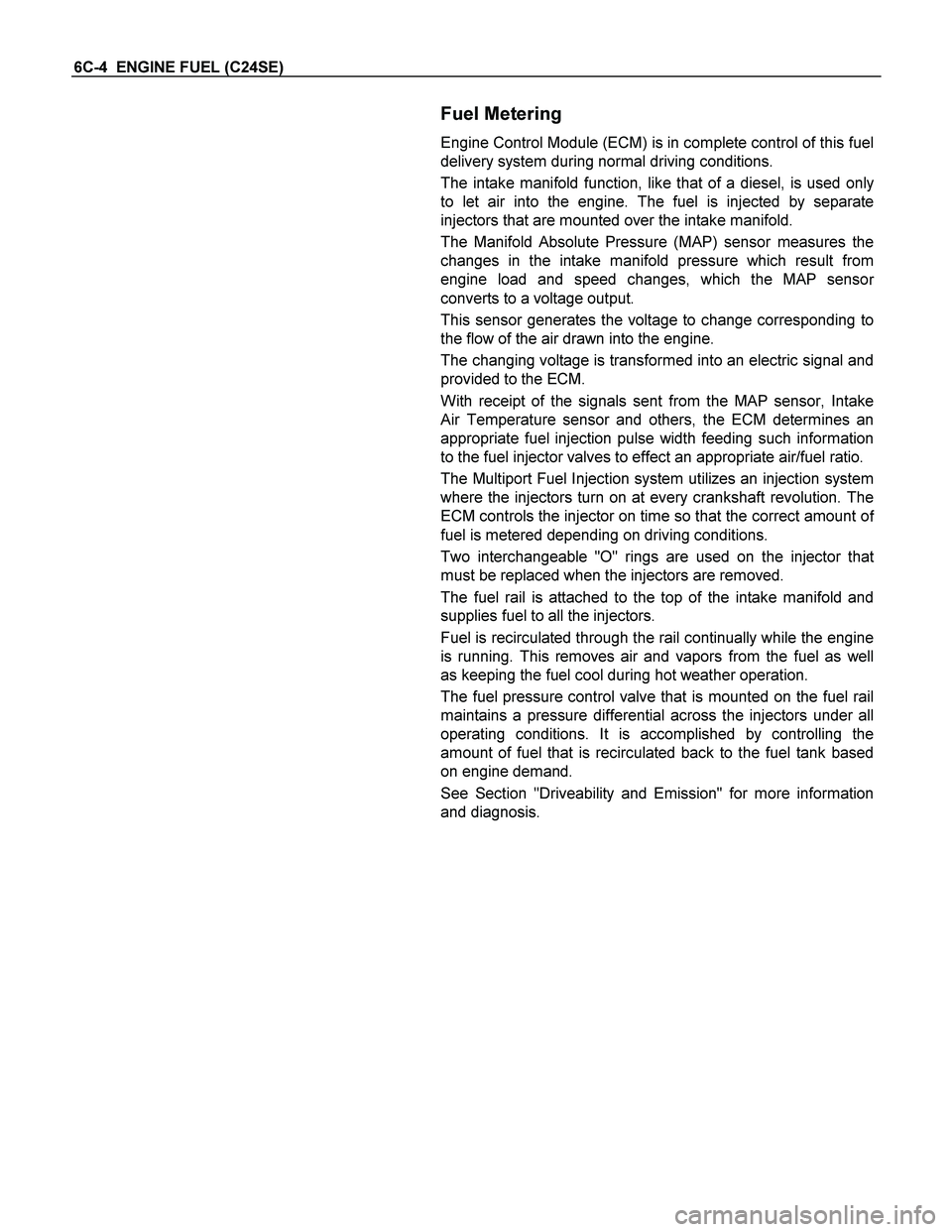
6C-4 ENGINE FUEL (C24SE)
Fuel Metering
Engine Control Module (ECM) is in complete control of this fuel
delivery system during normal driving conditions.
The intake manifold function, like that of a diesel, is used only
to let air into the engine. The fuel is injected by separate
injectors that are mounted over the intake manifold.
The Manifold Absolute Pressure (MAP) sensor measures the
changes in the intake manifold pressure which result from
engine load and speed changes, which the MAP senso
r
converts to a voltage output.
This sensor generates the voltage to change corresponding to
the flow of the air drawn into the engine.
The changing voltage is transformed into an electric signal and
provided to the ECM.
With receipt of the signals sent from the MAP sensor, Intake
Air Temperature sensor and others, the ECM determines an
appropriate fuel injection pulse width feeding such information
to the fuel injector valves to effect an appropriate air/fuel ratio.
The Multiport Fuel Injection system utilizes an injection system
where the injectors turn on at every crankshaft revolution. The
ECM controls the injector on time so that the correct amount o
f
fuel is metered depending on driving conditions.
Two interchangeable "O" rings are used on the injector tha
t
must be replaced when the injectors are removed.
The fuel rail is attached to the top of the intake manifold and
supplies fuel to all the injectors.
Fuel is recirculated through the rail continually while the engine
is running. This removes air and vapors from the fuel as well
as keeping the fuel cool during hot weather operation.
The fuel pressure control valve that is mounted on the fuel rail
maintains a pressure differential across the injectors under all
operating conditions. It is accomplished by controlling the
amount of fuel that is recirculated back to the fuel tank based
on engine demand.
See Section "Driveability and Emission" for more information
and diagnosis.
Page 2529 of 4264
ENGINE FUEL (C24SE) 6C-5
Fuel Filter
Fuel Filter and Associated Parts
Removal
CAUTION: When repair to the fuel system has been
completed, start engine and check the fuel system fo
r
loose connections or leakage. For the fuel system
diagnosis, see Section "Driveability and Emissions".
(2.4L)
1. Disconnect battery ground cable.
2. Disconnect the quick connector from the fuel filter.
3. Pull off fuel filter from the holder to side member side.
4. Remove the fuel filter.
Page 2530 of 4264
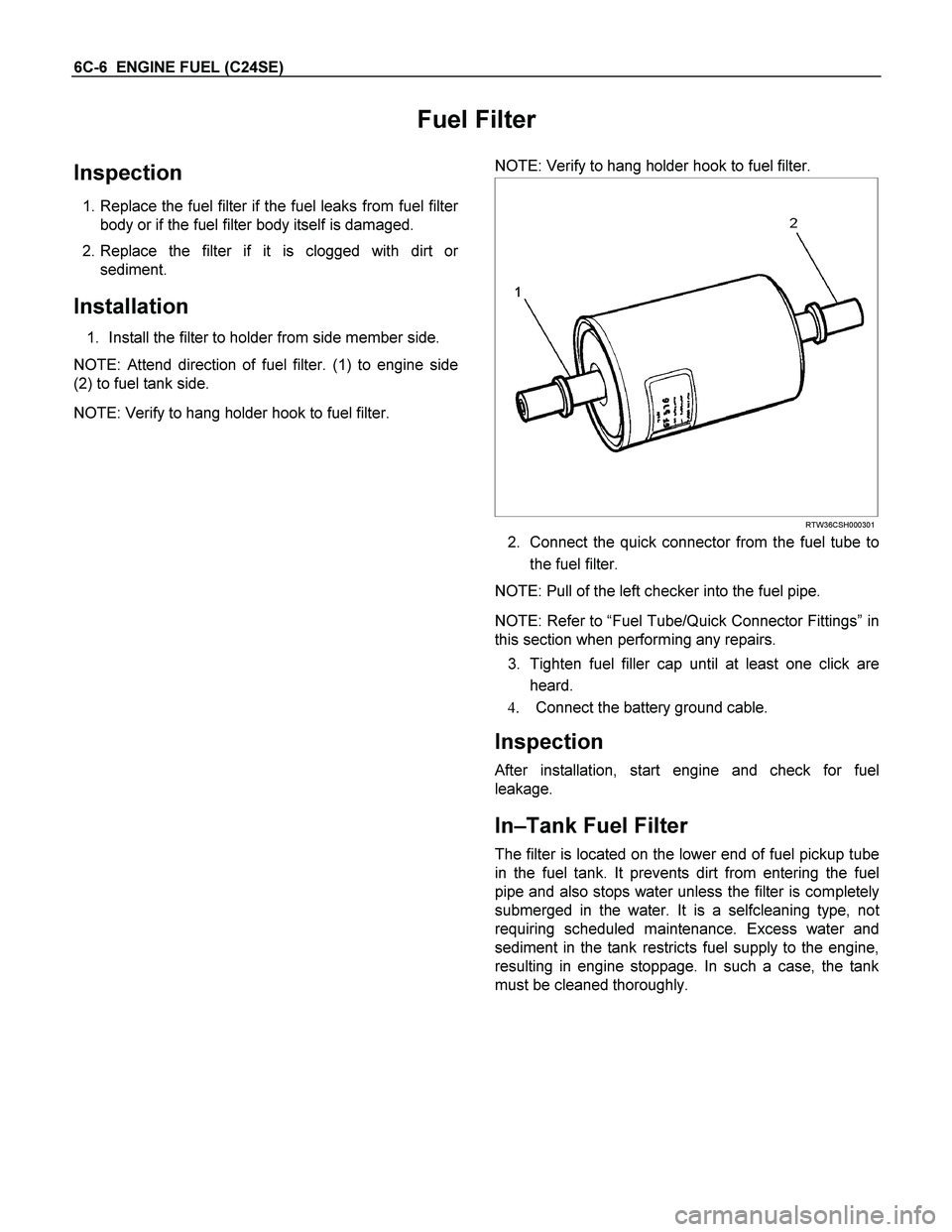
6C-6 ENGINE FUEL (C24SE)
Fuel Filter
Inspection
1. Replace the fuel filter if the fuel leaks from fuel filter
body or if the fuel filter body itself is damaged.
2. Replace the filter if it is clogged with dirt o
r
sediment.
Installation
1. Install the filter to holder from side member side.
NOTE: Attend direction of fuel filter. (1) to engine side
(2) to fuel tank side.
NOTE: Verify to hang holder hook to fuel filter.
NOTE: Verify to hang holder hook to fuel filter.
RTW36CSH000301
2. Connect the quick connector from the fuel tube to
the fuel filter.
NOTE: Pull of the left checker into the fuel pipe.
NOTE: Refer to “Fuel Tube/Quick Connector Fittings” in
this section when performing any repairs.
3. Tighten fuel filler cap until at least one click are
heard.
4. Connect the battery ground cable.
Inspection
After installation, start engine and check for fuel
leakage.
In–Tank Fuel Filter
The filter is located on the lower end of fuel pickup tube
in the fuel tank. It prevents dirt from entering the fuel
pipe and also stops water unless the filter is completely
submerged in the water. It is a selfcleaning type, no
t
requiring scheduled maintenance. Excess water and
sediment in the tank restricts fuel supply to the engine,
resulting in engine stoppage. In such a case, the tank
must be cleaned thoroughly.